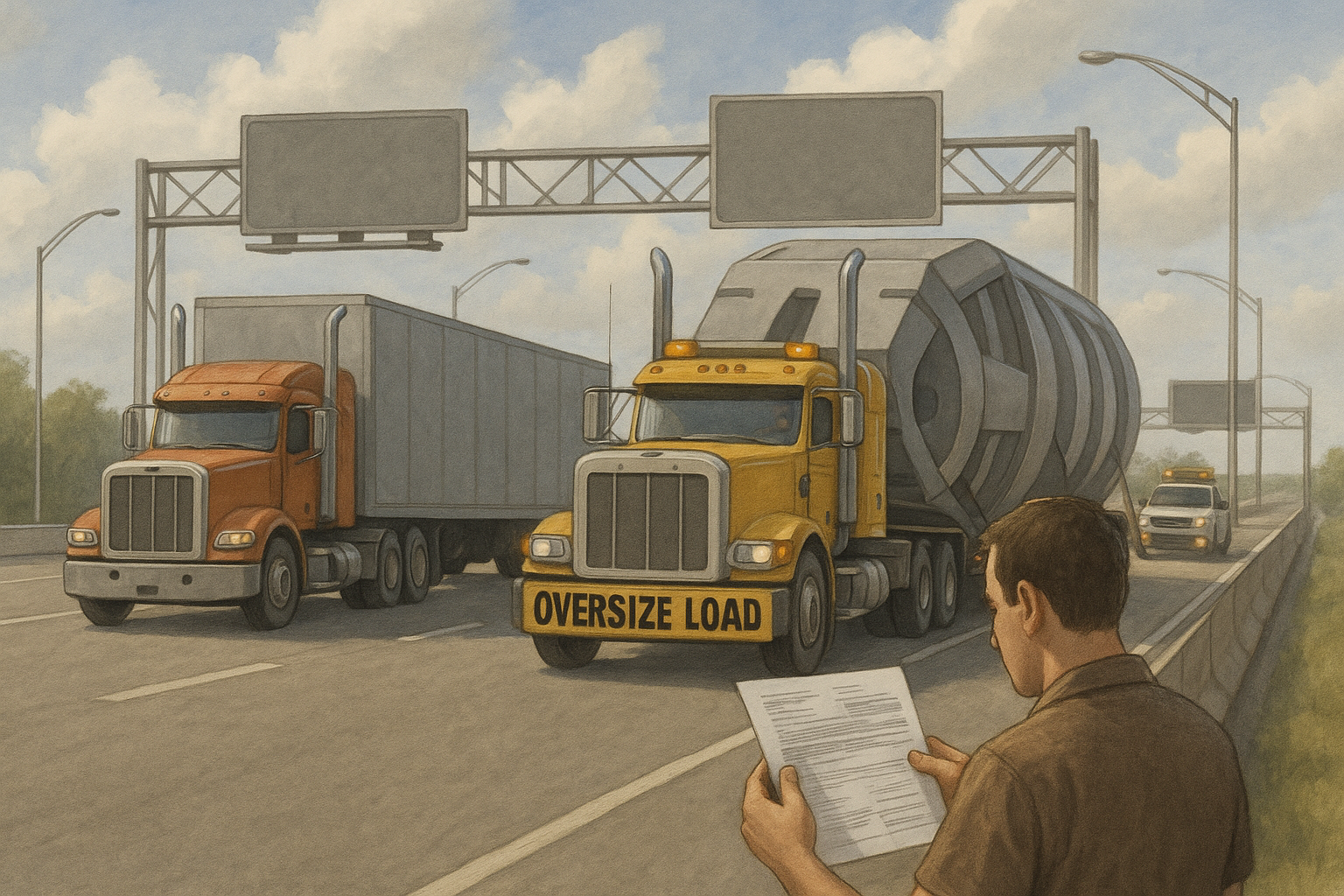Dimensional compliance isn’t the flashiest part of logistics, but if you’ve ever stared at a 10’ wide load on a standard flatbed and thought, “Do I need a permit for this?”—you’re not alone. Understanding when do you need an oversize permit isn’t just about memorizing a few numbers. It’s about navigating a complex web of width, height, length, and weight thresholds that vary wildly from one state line to the next.
At Reliable Permit Solutions, we make sense of these complexities so you don’t have to. Whether you’re a seasoned carrier or dispatching your first oversize load, here’s everything you need to know about when do you need an oversize permit—delivered in a way that’s actually digestible.
Width: When Does a Load Get Too Wide?
Most states cap legal load width at 8 feet, 6 inches (102 inches). But here’s where things get tricky—mirrors, lights, and safety devices are typically excluded from this measurement. Once your load exceeds that 102” standard, even by a few inches, that’s when you need an oversize permit for width.
Certain roads or bridges may have even tighter constraints, especially in urban corridors. If you’re hauling agricultural or construction equipment, expect to need permits more often than not. And let’s not forget, daylight-only travel and escort vehicle requirements usually kick in after about 12 feet wide.
Height: When the Sky Isn’t the Limit
Thinking vertically? You’ll hit regulatory ceilings fast. Most states impose a height limit of 13 feet, 6 inches. Anything taller? That’s when you need an oversize permit for height.
Bridges, overpasses, and power lines don’t care how important your load is. If your cargo surpasses legal limits, you risk damage, fines, or worse. Reliable Permit Solutions ensures your route is pre-cleared for vertical clearance issues, preventing accidents before they happen.
Length: How Long is Too Long?
Now, this gets nuanced. For single vehicles, the legal length is usually around 40 feet, while combination vehicles can go up to 65–75 feet, depending on the jurisdiction. But your cargo matters, too.
So, when do you need an oversize permit for length? When your vehicle or combined configuration exceeds local limits or when your load itself extends far beyond the trailer deck, creating overhang hazards. That’s where our expertise at Reliable Permit Solutions comes in—mapping load dimensions against each jurisdiction’s regs.
Weight: Not Just About the Scale
The federal gross vehicle weight limit is 80,000 pounds. But axle limits also matter—a truck might be legally gross-weighted but still illegal if an axle bears too much.
When do you need an oversize permit for weight? If you’re exceeding GVWR or axle weight ratings based on bridge formulas or state-specific tolerances, a permit is required. Plus, overweight permits usually demand detailed weight distribution data—something we help carriers navigate daily.
Multiple Offenses? You’ll Definitely Need a Permit
What if you’re a little over on width and height? That’s when you need an oversize permit for multiple exceedances. Most states won’t let you slide on any one metric if you’re exceeding others. Some may even require route surveys or pilot cars for more complex movements.
Every State Plays by Different Rules
No, there’s no universal standard. California, for example, limits height to 14 feet, while Arizona cuts that down to 13’6”. And that’s just one dimension.
So, when do you need an oversize permit by jurisdiction? Essentially, every time you’re crossing state lines with a dimensional load, assume the rules have changed. At Reliable Permit Solutions, we maintain a state-by-state permit database that updates in real-time—so you don’t have to guess.
The Equipment Matters, Too
When do you need an oversize permit by equipment type? A lowboy trailer might help you stay under the height limit, while a stretch trailer might push your length past compliance. Even your tie-down configuration can influence permit requirements.
We help you match the right equipment to the job and get the permits that match both your rig and your cargo.
Is It Permanent or Temporary?
Sometimes a load is only temporarily oversize—say you’ve added a removable crane boom or tool box. Other times, the load itself is just huge.
When do you need an oversize permit for temporary setups vs. permanent loads? If it’s removable, you might be able to configure it legally—but you’ll need expert judgment. That’s when working with Reliable Permit Solutions saves time and money.
When in Doubt, Ask the Experts
Borderline cases are the hardest. Maybe you’re within legal limits—but just barely. Or maybe one route is legal, but your preferred shortcut isn’t.
When do you need an oversize permit expert evaluation? When the risk of guessing wrong is a fine, delay, or mechanical disaster. That’s why logistics managers across North America trust Reliable Permit Solutions—to get it right the first time.
Final Word
So, when do you need an oversize permit? When any part of your load—width, height, length, or weight—crosses legal boundaries. When state lines blur compliance. When equipment configurations complicate things. And especially when time, safety, and money are on the line.
Reliable Permit Solutions is your go-to partner for clarity, compliance, and speed. Whether you’re hauling once a year or every day, we’ll make sure you know exactly when you need an oversize permit—and get it secured fast.
Let’s simplify your next haul. Contact Reliable Permit Solutions today.

